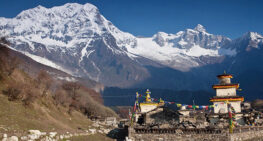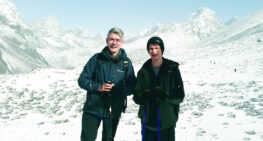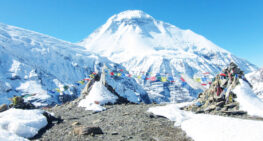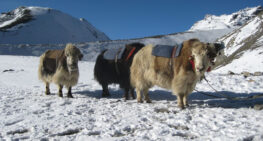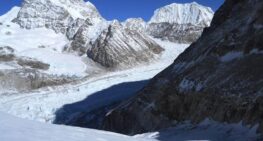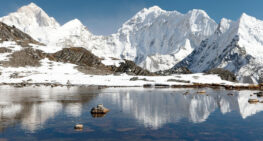‘adventure to world’s 3rd highest Mt. Kanchenjunga visiting both North and South base camps’
Trekking Highlights:
“Scenic and exciting flight and drives to Nepal’s Far Eastern Himalaya region of great scenic beauty
Walking into traditional hill villages of immense culture and traditions of Rai and Sherpa people
From green alpine forest pines-firs-rhododendron trees to remoreless fields of ice and glaciers
Scenic mountain views on daily walk within remote tradtional farm villages with impressive views
Adventure in the heart of world 3rd highest Mt. Kanchenjunga with excpetional panorama
The only adventure in the Himalaya visting both North and South Base Camps in one single journey”
Introduction:
Kanchenjunga Base Camp Trekking a fabulous adventure located Nepal Far Eastern Himalaya region the mountain straddles the border with Nepal and Sikkim (a small North East Indian state), Kanchenjunga in local Tibetan origin spelled as Kanchendonza which means 5 jewels dedicated to its five massive summit top of Mt. Kanchenjunga.
Kanchenjunga base camp trekking, an adventure which leads to both south and north base camps of Kanchenjunga massive mountain, perhaps this is the only trek in and around Himalaya and probably in the world, where you can enjoy being in two base camps of the same mountain in one single journey.
Mt. Kanchenjunga stands high as world 3rd highest and high mountains and second highest peak in Nepal with an altitude 8,586 m and 28,169 ft high.
Mt. Kanchenjunga of great beauty and grace first ascent in 1955 from Nepal South base camp by British Expedition led by late Sir George Band, where most expedition at present climbs from North Base Camp around Pangpema.
Kanchenjunga base camp trekking begins with scenic flight towards South East Nepal on Terai belt where an exciting drive leads you at Ilam town famous for its vast tea garden to reach our stating point of the adventure.
From Sukhetar walk leads at first to Kanchenjunga South Base Camp at near Ramche around Yalung glacier after trekking past serene and enchanting alpine forest of rhododendron and pine trees within remote rural farm villages, and then our adventure continues towards Kanchenjunga North Base Camp at Pangpema, the highest point of our adventure standing at 5,143 m with stunning panorama of massif Kanchenjunga and adjoining peaks.
After a fabulous and exciting time within Kanchenjunga base camps, our adventure concludes heading back to Sukhetar for the drive towards Ilam town and the toward Nepal’s flat Terai for sweeping panoramic flight back to Kathmandu.
S. N |
Cost Includes
- Required Trekking Permit & government tax
- Trekking Equipments, Trekking Map
- Full Board Plan (breakfast, lunch, dinner, accommodation, tea or coffee) during trek,
- An experienced licensed holder Guide and required Porters
- Food, drinks, salary, insurance, equipment, transportation, accommodation, Medical kit box and local tax for guide & porters,
- Transportation by flight, Tourist Bus and car, All necessary transportation while sightseeing
- TIMS (Trekkers' Information Management Systems)
- All guided sightseeing tour in Kathmandu and entry fees
- Airport pick up and drop with an escort
cost excludes
- Lunch and dinner in Kathmandu.
- Your travel insurance
- International flight fare
- Any expense of personal nature
- Nepal entry visa fee US $40 for 30 days
- Any kinds of Bar bills
- Laundry service in Kathmandu and mountain
- Battery charge, hot shower while you are in trekking
